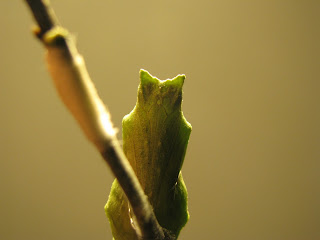In this picture above, at the top of the pupa there are these pointed projections on either side of the "head", and right below them are the dark eye spots. From this, you know that you are going to get butterflies in a few days, and that he pupa didn't go into hibernation, as they sometimes do (that's a topic for later).
Here's a view of the same pupa from the side. When a pupa first forms, the top half is all transparent green when you hold it up to the light. Only a portion of the abdomen is dark. As time passes and the butterfly forms inside, the tissues stop being transparent. In this picture, the head, part of the future thorax, and the top half of the wings are starting to form.
This is within 24 hours of the butterfly emergence now. You can clearly see the forewings (the hind wings are hidden underneath the forewings), and not only that, you can see yellow spots on the forewings. There are also black stripes forming on the sides of the abdomen. The next several shots are sequential photographs from when the butterfly actually emerged from its pupa, at 3:17AM. The whole process takes less than a minute! It uses its wings and legs to push open a triangular flap at the top and front of its pupa shell, and uses its legs to grab onto whatever is nearby, and pulls itself out of the shell.
After that, it has to pump fluid into the veins of the wings to expand them. It has always amazed me how the final wings can be so big, considering how small and crumpled the wings are when it first emerges. The butterfly usually hangs vertically during this time so that the wings expand also with the aid of gravity. This also ensures that the wings are straight after they've formed and dried. After about 15 minutes, the wings are fully expanded, but it takes another 2 hours or so before they are dried and stiff enough to support flight.
This picture is slightly out of focus because this butterfly was crawling and flying around, and really wouldn't hold still for me. I now anxiously wait for the other two butterflies to emerge. Oh and in case you are wondering, it's a boy. :) The females have a lot more blue coloration on the hind wings. Hopefully one of the other butterflies will be a female so I can post pictures for comparison.










No comments:
Post a Comment